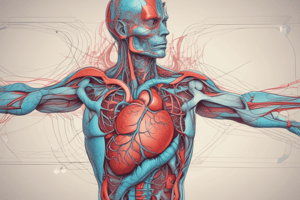Podcast
Questions and Answers
What is the primary function of elastic arteries?
What is the primary function of elastic arteries?
To propel blood away from the heart
Which type of artery has a thicker smooth muscle layer?
Which type of artery has a thicker smooth muscle layer?
Muscular arteries
What is the main difference in elasticity between elastic and muscular arteries?
What is the main difference in elasticity between elastic and muscular arteries?
Elastic arteries are highly elastic, while muscular arteries are less elastic
Which type of artery has a larger diameter?
Which type of artery has a larger diameter?
What is the function of the smooth muscle layer in muscular arteries?
What is the function of the smooth muscle layer in muscular arteries?
What is the role of vasa vasorum in both elastic and muscular arteries?
What is the role of vasa vasorum in both elastic and muscular arteries?
What type of epithelium lines the trachea?
What type of epithelium lines the trachea?
What is the function of the cilia on the epithelial lining of the trachea?
What is the function of the cilia on the epithelial lining of the trachea?
What type of epithelium lines the alveoli of the lungs?
What type of epithelium lines the alveoli of the lungs?
What is the main difference between the epithelial lining of the trachea and the lungs?
What is the main difference between the epithelial lining of the trachea and the lungs?
Study Notes
Elastic Arteries
- Thick walls with abundant elastic fibers
- Highly elastic, with stretch and recoil properties
- Less smooth muscle relative to elastic fibers
- Large diameter
- Examples: Aorta, Pulmonary artery
- Absorb and dampen the pressure fluctuations generated by the heartbeat
- Maintain continuous blood flow even during diastole (relaxation phase of the heart)
- Less adaptable to changes in blood flow demands
- Vasa vasorum present in the tunica adventitia (outer layer)
Muscular Arteries
- Thicker smooth muscle layer, less elastic fibers
- Less elastic, with limited stretch and recoil properties
- More smooth muscle relative to elastic fibers
- Medium-sized diameter
- Examples: Brachial artery, Renal artery
- Constrict or dilate to regulate blood flow and blood pressure
- Maintain continuous blood flow even during diastole (relaxation phase of the heart), and adjust blood flow based on tissue needs
- More adaptable to changes in blood flow demands
- Vasa vasorum present in the tunica adventitia (outer layer)
Respiratory System
Trachea
- Lined by pseudostratified ciliated columnar epithelium
- Epithelial lining consists of a single layer of cells that appear stratified due to the varying heights of the nuclei
- Each cell has cilia on its surface, which help in the movement of mucus and trapped particles upward towards the throat, facilitating the process of mucociliary clearance
Lungs
- Lined by simple squamous epithelium
- Alveoli, the functional units of the lungs where gas exchange occurs, are lined by a thin layer of simple squamous epithelium
Studying That Suits You
Use AI to generate personalized quizzes and flashcards to suit your learning preferences.
Description
This quiz covers the structure and functions of elastic arteries, including their composition, properties, and examples.





